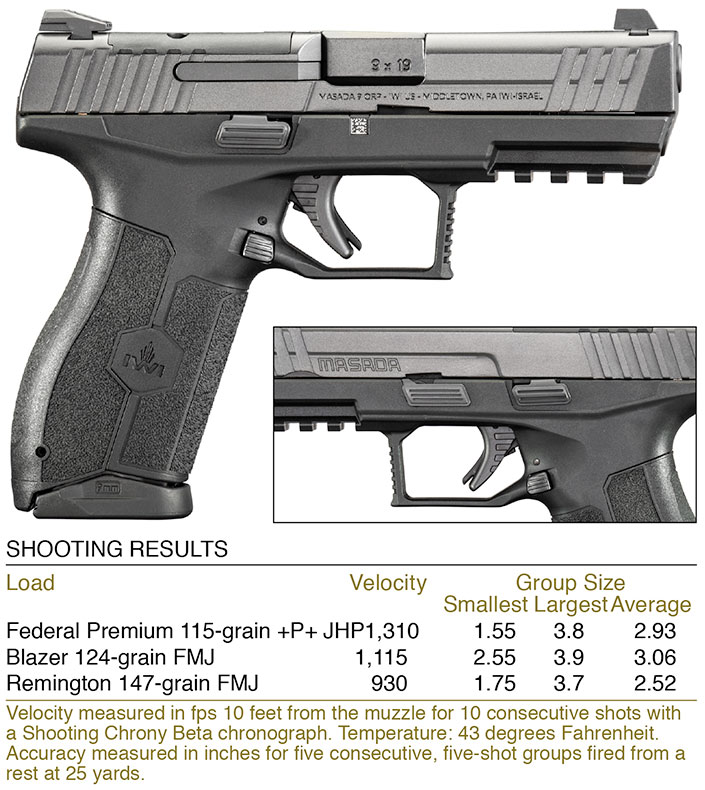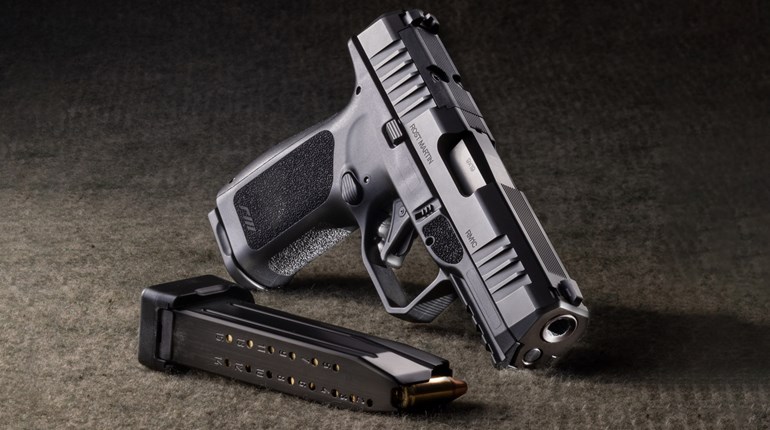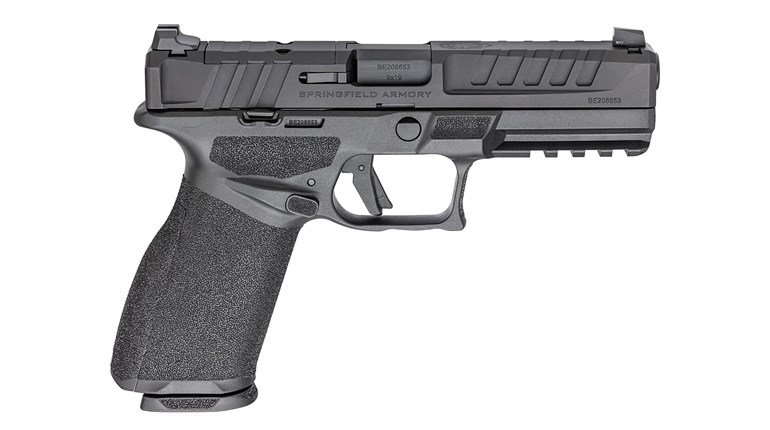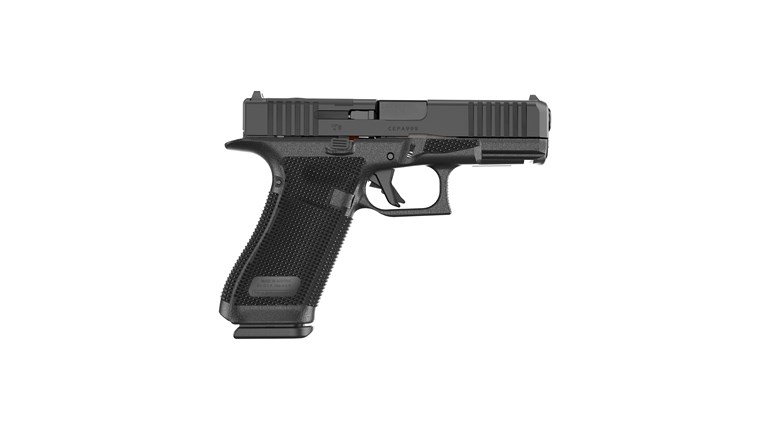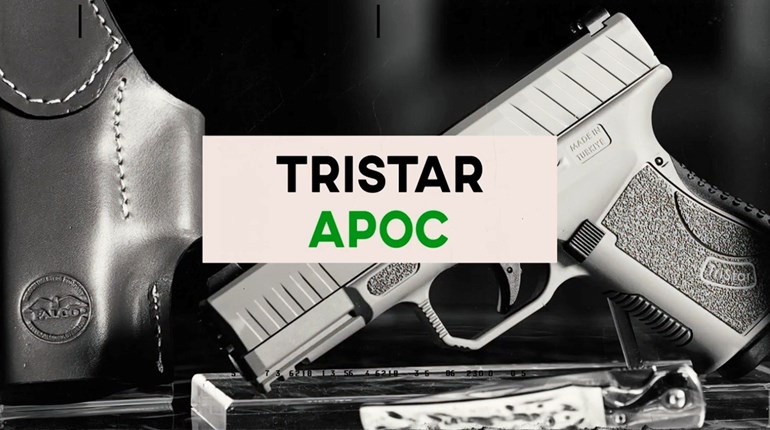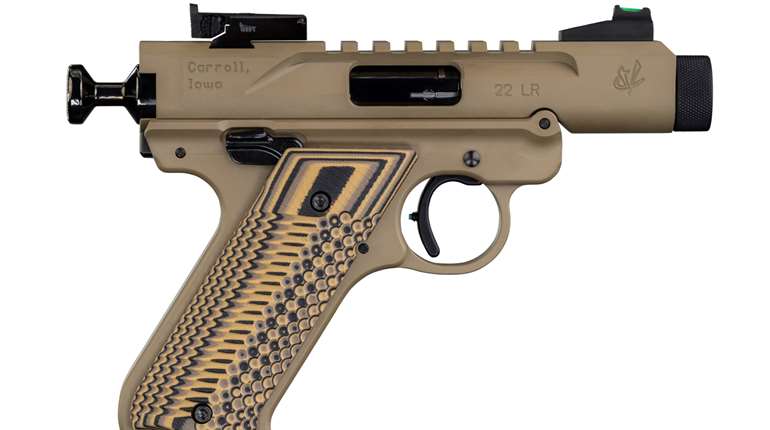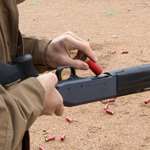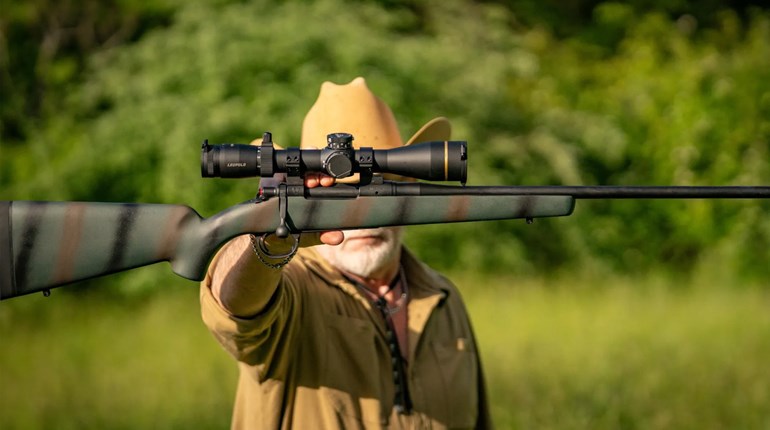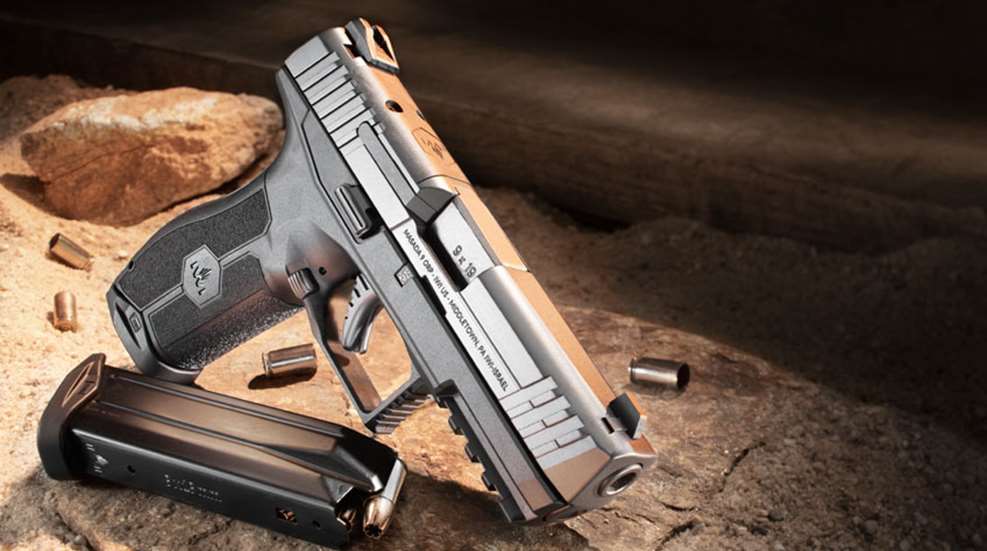
The nation of Israel is roughly equivalent in both physical size and population numbers to the state of New Jersey. Despite being so small, Israel has an extremely advanced armaments industry, much like New Jersey would if Pennsylvania and New York kept trying to invade the Garden State every few years.
Most nations that size are lucky to have the industrial plant and arms know-how to license-build copies of foreign designs, but Israel is among a handful of nations capable of scratch-building main battle tanks and jet fighters.
It’s not surprising, therefore, that its domestic arms industry has moved well beyond its early days of stamped, sheet metal Uzi submachine guns and Browning High Power clones to turning out original, advanced designs like the Tavor bullpup rifle and the subject of today’s review, the polymer-frame, 9 mm IWI Masada pistol.
A service-size, 17+1-shot pistol that’s available in any color you want—as long as it’s black—the Masada weighs in at 26 ounces empty and 33.6 ounces with a full cargo of Speer 124-grain Gold Dot hollow points. It ships in a flat black cardboard box, with the IWI Masada logo on the lid and a foam insert cutout for the gun, spare magazines and backstraps.
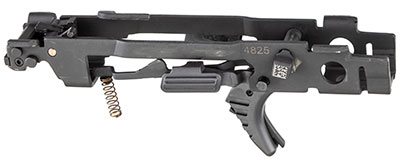
At first glance, the Masada looks like yet another one of the bunches of quasi-Glock clones on the market these days. It’s getting hard to swing a cat without hitting a polymer-frame, striker-fired pistol with internals that borrow heavily from the Austrian design, but a quick look under the hood will reveal some notable differences between IWI’s offering and Gaston’s blaster (and its various imitators).
The most obvious difference is the takedown mechanism, which is extremely SIG Sauer-esque, featuring a lever that must be rotated 90 degrees downward and is prevented from doing so if the slide is not in the locked-back position.
This feature is touted in ad copy by IWI, that makes a point of noting there’s no need to pull the trigger to fieldstrip the pistol. It doesn’t take a rocket surgeon to decipher at whom that marketing barb is aimed.
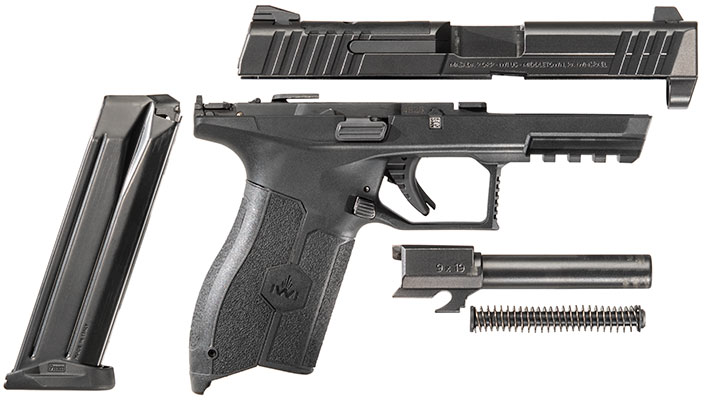
With the pistol field-stripped, another difference in the mechanism is apparent. The Glock—and pistols influenced by it—tend to use a simple, all-in-one trigger-bar assembly that interfaces directly with the striker and functions as both a trigger bar and a sear. In the Masada, the trigger bar acts against a separate pivoting sear, which then interfaces with the striker.
The result of this mechanism is a pretty nice trigger pull, actually. Many guns of this sort have trigger pulls noted for odd hesitations or hitches, as well as variable weight across the length-of-pull, as the trigger bar bumps and slides out of engagement with the striker, while the Masada has a light and even take-up devoid of stacking. It broke cleanly and consistently at 5 pounds on the test gun.
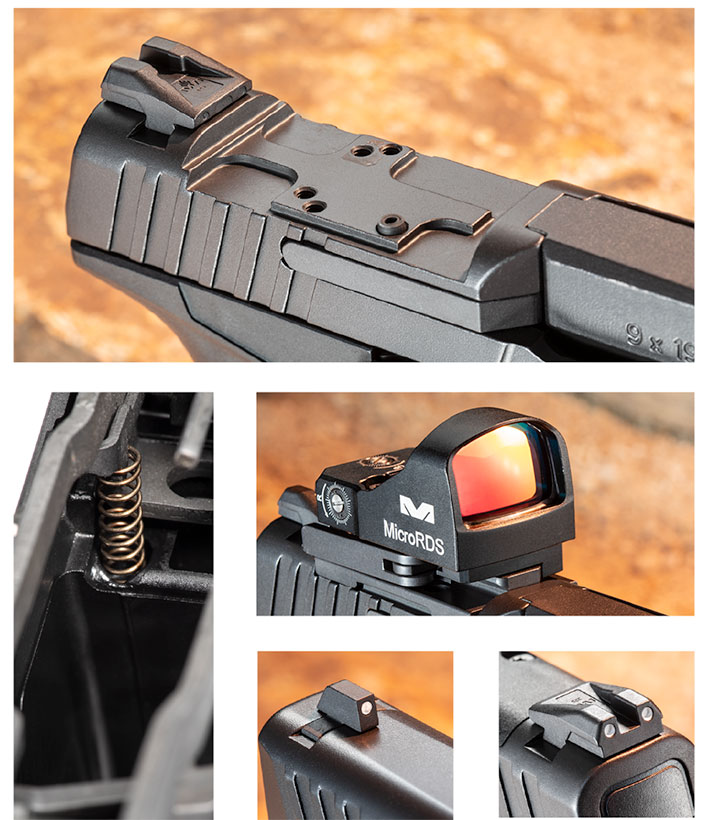
I know it’s a cliché, but the trigger felt like a really slick double-action revolver trigger, albeit with a much shorter travel. Trigger reset, while not notably short, was fairly positive. As stock striker-fired triggers go, this is among the better ones.
The trigger, as is increasingly common, sits in a removable chassis that is the serialized part of the firearm. As is the norm with these systems, the sheet-steel chassis both contains the lockwork and also features four small tabs that are bent outward to form the frame rails of the pistol.
The rest of the controls on the frame match the trigger in user-friendliness. The slide stop is well-positioned, both easy to access yet difficult to inadvertently apply. In keeping up with the current trend, southpaws aren’t left out, as the slide stop is mirrored on both sides of the pistol.
The Masada’s magazine release is truly ambidextrous, rather than merely reversible, and should fall readily under the thumb of the shooter. If the reach to the button is a little too long or short, one of the other backstrap sizes that ship with the pistol will likely fix that. The pistol comes wearing the middle size, but there are smaller and larger ones in the box.
The grip itself is well-contoured and features generously large relief cuts behind the trigger. These aid in being able to get a good reach to the trigger without the trigger finger coming into contact with the frame at any point during the pull.
The trigger guard is large enough to admit a gloved finger, squared-off and features serrations on the front in case the firer feels like re-enacting the ’80s and putting their support-side index finger there.
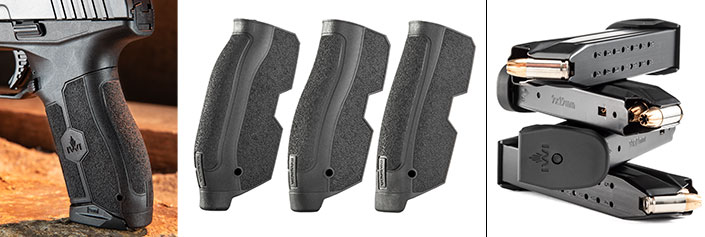
Forward of the trigger guard is the expected accessory rail on the dustcover. In this case, it’s a four-slot MIL-STD 1913 affair, of ample length to take the normal array of full-size weapon-mounted lights such as SureFire’s X300U or the various TLR-1 variants from Streamlight.
The overall texture of the frame is just the basic, matte-black polymer, with panels inset into the sides, frontstrap and backstrap featuring a coarse texture reminiscent of the one SIG Sauer is using these days. Not super aggressive, more like a tamer, molded plastic version of skateboard tape.
Up top, the Masada features sets of wide, shallow cocking serrations front and rear. The front of the slide is stylishly beveled, and the top has rounded edges but a wide flat surface along the sighting plane.
The sights themselves are three-dot “combat”- type sights, with the rear having a sloped non-snag contour that can make one-handed slide manipulations a bit of a chore. The front and rear sight dovetails would appear to be the same dimensions as standard SIG P-series sights, which should make it easy to find pretty much whatever sight configuration you want.
The extractor is of the external type and is quite large. It protrudes enough with a round in the chamber that it serves as both a visual and tactile loaded-chamber indicator. The cold-hammer-forged, 4.1-inch barrel features polygonal rifling, with all the caveats regarding unjacketed, lead bullets that implies.
While overseas variants of the Masada are available without an optics cut, all the Masadas sold on the U.S. market feature a slide cut for MRDS optics. The cutout is protected by a plastic cover plate contoured to match the slide and stamped with the IWI logo.
Included in the box are adapter plates for the Trijicon RMR, Leupold DeltaPoint, Vortex Venom and SIG Sauer Romeo optics (including, of course, other optics sensible enough to use one of these rapidly standardizing mounting-hole patterns.)
The shooting portion of the test got off to a good start, with the gun having digested a fairly large variety of ammunition brands in a variety of bullet weights and configurations without any real drama when a small box from Meprolight showed up on my front porch. “Weird,” I thought, “I don’t remember ordering anything from Meprolight…”
Inside was the company’s new MicroRDS optic. In most respects, it looked like a pretty conventional MRDS, but what stood out was the mounting system. The optic itself featured a teeny-tiny throw-lever mount.
In the box with the optic was an adapter plate to fit the cutout on the Masada, and the adapter plate had a small longitudinal rail on it with a single lateral notch; a sort of dollhouse-scale version of a Picatinny rail.
I was initially extremely dubious about this mounting setup. I know Meprolight has research dudes and engineers and I’m sure this thing had been R&D’ed extensively, but… Well, a reciprocating pistol slide puts just stupid stresses on an optic and its mount. It slams backward and forward at crazy g-forces every time the pistol cycles.
Gentle reader, I am not going to lie, mindful of the idea of having my dental plan suddenly activated by a flying hunk of anodized aluminum and optical-grade glass, the first time I took the pistol to the range with the optic mounted, I fired it with the turtleneck collar on my wind shell zipped up over my nose and mouth.
As it turned out, I needn’t have feared. Nearly half a case of ammunition later, the sight’s grip on the rail was every bit as snug as it had been to start. On the downside, the base of the throw-lever mount causes it to sit high enough that it completely obscures the iron sights.
On the upside, it’s a throw-lever mount, so if the optic were to, for some reason, go toes-up on you, you could pop it off quickly and without the need for tools.
As for the sight itself, it’s a conventional projection-type, with a 3-MOA dot adjustable across 10 brightness levels. You have to poke the up button to turn it on and, if left to its own devices, it will power itself down again 8.5 hours later.
If you want to turn it off manually before that time has elapsed, pressing and holding the down button for 4 seconds will do the job. Projected battery life is hinted at nowhere in the included literature, but a CR2032 is a pretty big battery, and changing it when you set your clocks back in the fall would be conservative.
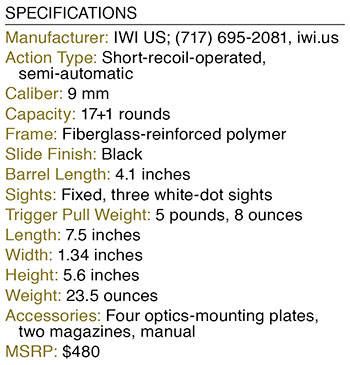 Speaking of changing the battery, this can be done through the top of the sight without disturbing the zero.
Speaking of changing the battery, this can be done through the top of the sight without disturbing the zero.
As far as the throw-lever mount being able to be used without disturbing the zero, popping it on and off a couple times had no noticeable effect while shooting the gun offhand at 10 yards. It’s possible there could be a more discernible effect at 25 yards when shot from a Ransom Rest, of course.
By the end of testing, the gun had gone two dozen rounds shy of a thousand while experiencing only a single malfunction—an anomalous failure-to-extract on a round of Sellier & Bellot 115-grain FMJ on round number 206 of the test.
Accuracy testing also returned quite adequate results, with a couple of sub-2-inch, 25-yard groups. (Although with about an inch of height over the bore, the Meprolight dot sight required remembering mechanical sight offset at close ranges, analogous to that seen in an AR.)
All in all, IWI has delivered a pretty impressive package with the Masada. It’s fully ambidextrous and optics ready, and its sub-$500 MSRP is extremely aggressive for a pistol with those features. If the test sample (a production gun) is anything to go by, the Masada platform looks to have a bright future ahead of it.
